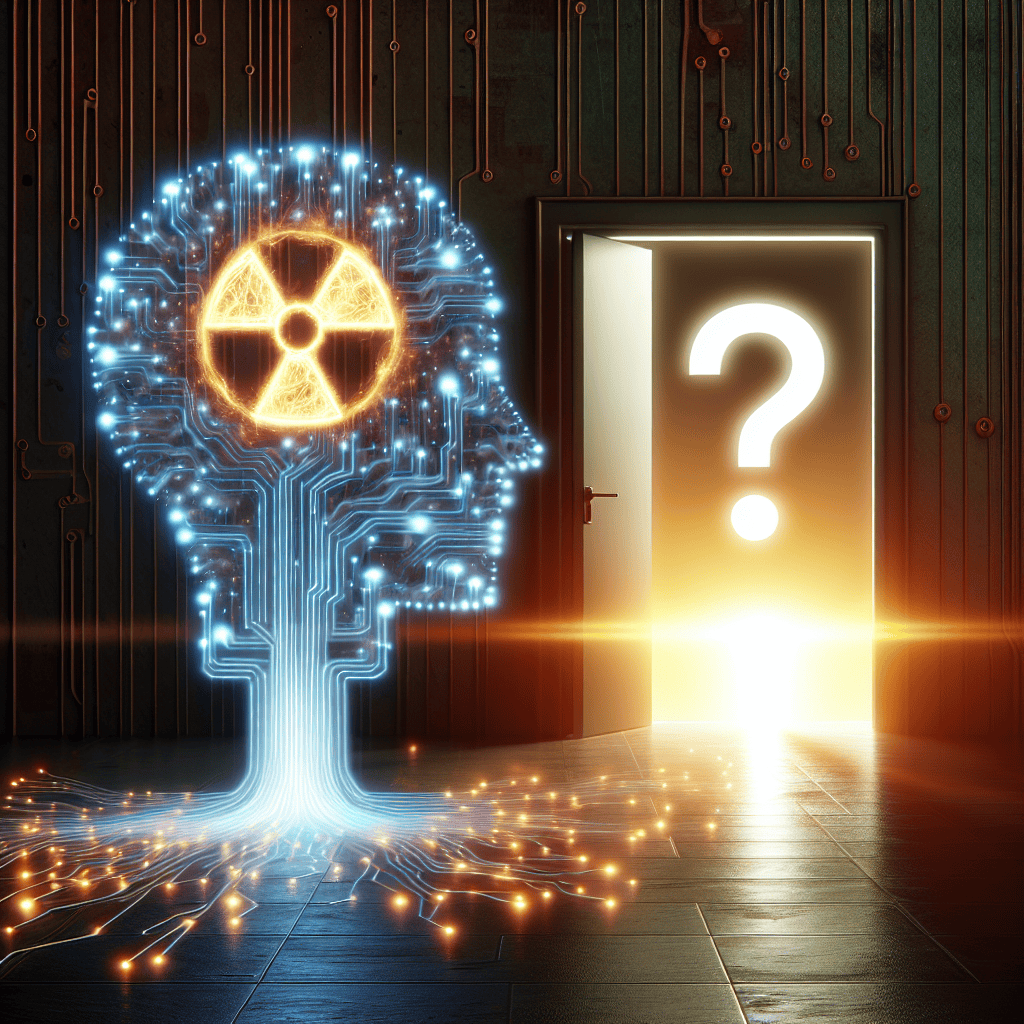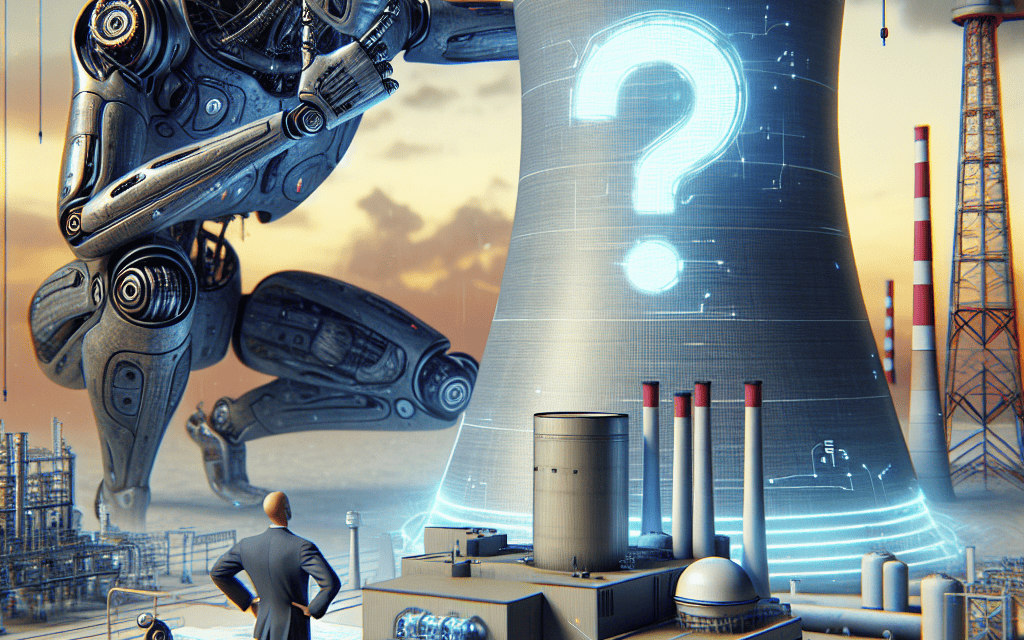“Navigating the Crossroads: The Future of AI in Nuclear Energy”
Introduction
The integration of artificial intelligence (AI) into the nuclear energy sector has been heralded as a transformative force, promising enhanced efficiency, safety, and innovation. However, recent developments have highlighted significant challenges that threaten to stall this technological surge. As the industry grapples with regulatory hurdles, cybersecurity concerns, and the complexities of integrating AI with legacy systems, stakeholders are forced to reassess the trajectory of AI’s role in nuclear energy. This situation prompts critical questions about the future: How can these obstacles be overcome, and what strategies will ensure that AI fulfills its potential in revolutionizing nuclear power? The path forward requires a nuanced understanding of both the technological possibilities and the practical limitations that define this evolving landscape.
Understanding The AI Surge In Nuclear Energy
The integration of artificial intelligence (AI) into nuclear energy has been heralded as a transformative development, promising to enhance efficiency, safety, and sustainability. This surge in AI applications within the nuclear sector is driven by the need to address complex challenges such as optimizing reactor performance, predicting maintenance needs, and ensuring stringent safety protocols. However, despite the initial enthusiasm, the journey towards fully integrating AI into nuclear energy has encountered significant obstacles, prompting a reevaluation of its potential and future trajectory.
To begin with, AI’s role in nuclear energy is multifaceted, encompassing predictive analytics, automation, and real-time monitoring. Predictive analytics, for instance, allows for the anticipation of equipment failures before they occur, thereby reducing downtime and maintenance costs. Automation, on the other hand, can streamline operations, minimizing human error and enhancing overall efficiency. Furthermore, real-time monitoring facilitated by AI can ensure that reactors operate within safe parameters, thus bolstering safety measures. These capabilities underscore the potential of AI to revolutionize nuclear energy, making it more reliable and cost-effective.
Nevertheless, the implementation of AI in nuclear energy is not without its challenges. One of the primary concerns is the reliability of AI systems in critical applications. Given the high stakes involved in nuclear energy, any malfunction or error in AI algorithms could have catastrophic consequences. This necessitates rigorous testing and validation of AI systems, which can be both time-consuming and costly. Moreover, the complexity of nuclear reactors presents a unique challenge for AI, as these systems must be capable of processing vast amounts of data and making decisions in real-time.
In addition to technical challenges, there are also regulatory hurdles to consider. The nuclear industry is heavily regulated, with stringent safety standards that must be met. Integrating AI into this framework requires navigating a complex web of regulations, which can slow down the adoption process. Furthermore, there is a need for regulatory bodies to develop new guidelines and standards specifically for AI applications in nuclear energy, a task that requires significant time and resources.
Another critical issue is the cybersecurity risk associated with AI systems. As nuclear facilities become more reliant on digital technologies, they become more vulnerable to cyberattacks. Ensuring the security of AI systems is paramount, as any breach could have dire consequences. This necessitates the development of robust cybersecurity measures, which can further complicate the integration process.
Despite these challenges, the potential benefits of AI in nuclear energy cannot be overlooked. As the world seeks to transition to cleaner energy sources, nuclear power remains a vital component of the energy mix. AI has the potential to make nuclear energy more competitive by reducing costs and enhancing safety. However, realizing this potential requires addressing the aforementioned challenges through collaboration between industry stakeholders, regulatory bodies, and technology developers.
In conclusion, while the AI surge in nuclear energy has hit a snag, it is not insurmountable. By addressing technical, regulatory, and cybersecurity challenges, the nuclear industry can harness the power of AI to drive innovation and sustainability. The path forward will require a concerted effort to balance the benefits of AI with the need for safety and security, ensuring that the integration of AI into nuclear energy is both effective and responsible. As this journey unfolds, it will be crucial to remain vigilant and adaptable, ready to overcome obstacles and seize opportunities as they arise.
Challenges Facing AI Integration In Nuclear Power
The integration of artificial intelligence (AI) into nuclear power has been heralded as a transformative development, promising to enhance efficiency, safety, and operational performance. However, as the nuclear industry increasingly embraces AI technologies, several challenges have emerged that could impede their seamless integration. Understanding these challenges is crucial for stakeholders aiming to harness AI’s full potential in this critical sector.
One of the primary challenges facing AI integration in nuclear power is the complexity of nuclear systems themselves. Nuclear reactors are intricate, with numerous interdependent components and processes. This complexity necessitates highly sophisticated AI models capable of accurately simulating and predicting reactor behavior under various conditions. Developing such models requires extensive data, which is often difficult to obtain due to the sensitive nature of nuclear operations and the stringent regulatory frameworks governing them. Consequently, AI systems may struggle to achieve the level of precision and reliability required for critical applications in nuclear power.
Moreover, the nuclear industry is characterized by a strong emphasis on safety and risk management. Any technological innovation, including AI, must undergo rigorous validation and verification processes to ensure it does not compromise safety standards. This requirement poses a significant hurdle for AI integration, as traditional validation methods may not be directly applicable to AI systems. The inherent opacity of some AI models, particularly those based on deep learning, further complicates this issue. These models often operate as “black boxes,” making it challenging to understand their decision-making processes and to ensure they align with established safety protocols.
In addition to technical challenges, there are also organizational and cultural barriers to AI adoption in the nuclear sector. The industry is traditionally conservative, with a workforce that may be resistant to change and skeptical of new technologies. This cultural inertia can slow the adoption of AI, as employees may be reluctant to trust AI systems or may lack the necessary skills to effectively implement and manage them. To overcome this barrier, comprehensive training programs and change management strategies are essential to foster a culture of innovation and adaptability within nuclear organizations.
Furthermore, regulatory challenges present another significant obstacle. The nuclear industry is subject to stringent regulations designed to protect public safety and the environment. These regulations can be slow to adapt to technological advancements, creating a lag between the development of AI technologies and their approval for use in nuclear applications. Regulatory bodies must balance the need for innovation with the imperative to maintain safety and security, which can result in lengthy approval processes that delay AI integration.
Despite these challenges, the potential benefits of AI in nuclear power are substantial. AI can enhance predictive maintenance, optimize fuel usage, and improve emergency response capabilities, among other advantages. To realize these benefits, stakeholders must address the aforementioned challenges through collaborative efforts involving industry leaders, regulatory bodies, and technology developers. By fostering an environment conducive to innovation and by developing robust frameworks for AI validation and regulation, the nuclear industry can overcome the current hurdles and pave the way for a future where AI plays a pivotal role in advancing nuclear energy.
In conclusion, while the integration of AI into nuclear power faces significant challenges, these obstacles are not insurmountable. Through concerted efforts to address technical, organizational, and regulatory barriers, the nuclear industry can unlock the transformative potential of AI, ultimately enhancing the safety, efficiency, and sustainability of nuclear energy.
The Role Of AI In Enhancing Nuclear Safety
The integration of artificial intelligence (AI) into nuclear energy systems has been heralded as a transformative development, promising to enhance safety, efficiency, and reliability. AI technologies, with their ability to process vast amounts of data and identify patterns beyond human capability, have been deployed to monitor reactor conditions, predict maintenance needs, and optimize energy output. However, despite these promising applications, the AI surge in nuclear energy has encountered significant challenges that warrant careful consideration.
Initially, AI’s role in nuclear safety was envisioned as a means to augment human oversight, providing an additional layer of security through real-time data analysis and predictive modeling. For instance, AI systems can continuously monitor reactor temperatures, pressure levels, and radiation emissions, alerting operators to potential anomalies before they escalate into critical issues. This proactive approach not only enhances safety but also extends the operational lifespan of nuclear facilities by preventing wear and tear through timely interventions.
Moreover, AI’s predictive capabilities are particularly valuable in maintenance scheduling. By analyzing historical data and current operational conditions, AI can forecast when specific components are likely to fail, allowing for preemptive repairs. This reduces the risk of unexpected shutdowns and minimizes downtime, thereby improving the overall efficiency of nuclear plants. Furthermore, AI-driven simulations can assist in training personnel, providing virtual environments where operators can practice responding to various scenarios without the risks associated with real-world exercises.
Despite these advantages, the deployment of AI in nuclear energy is not without its hurdles. One of the primary concerns is the reliability of AI systems in high-stakes environments. While AI can process information at unprecedented speeds, its decision-making processes are often opaque, leading to what is known as the “black box” problem. This lack of transparency can be problematic in nuclear settings, where understanding the rationale behind a decision is crucial for ensuring safety and compliance with regulatory standards.
Additionally, the integration of AI into existing nuclear infrastructure presents technical and logistical challenges. Many nuclear facilities operate with legacy systems that may not be compatible with modern AI technologies. Retrofitting these systems requires significant investment and expertise, which can be a barrier for widespread adoption. Furthermore, the cybersecurity risks associated with AI systems cannot be overlooked. As nuclear facilities become more digitized, they may become targets for cyberattacks, necessitating robust security measures to protect sensitive data and critical operations.
In light of these challenges, the path forward for AI in nuclear energy involves a balanced approach that leverages the benefits of AI while addressing its limitations. Collaborative efforts between AI developers, nuclear engineers, and regulatory bodies are essential to create transparent, reliable, and secure AI systems. Moreover, ongoing research and development are needed to refine AI algorithms, enhance their interpretability, and ensure their compatibility with existing nuclear technologies.
In conclusion, while AI holds significant promise for enhancing nuclear safety, its integration into the nuclear energy sector is a complex endeavor that requires careful navigation. By addressing the technical, logistical, and security challenges, stakeholders can harness the full potential of AI to create safer and more efficient nuclear energy systems. As the industry moves forward, a cautious yet optimistic approach will be key to realizing the benefits of AI while safeguarding against its risks.
Regulatory Hurdles For AI In Nuclear Energy

The integration of artificial intelligence (AI) into nuclear energy has been heralded as a transformative development, promising to enhance efficiency, safety, and operational effectiveness. However, as this technological surge gains momentum, it encounters significant regulatory hurdles that could impede its progress. Understanding these challenges is crucial for stakeholders aiming to harness AI’s potential in this critical sector.
To begin with, the nuclear energy industry is one of the most heavily regulated sectors globally, primarily due to the inherent risks associated with nuclear materials and the potential consequences of any mishaps. Regulatory bodies, such as the Nuclear Regulatory Commission (NRC) in the United States and the International Atomic Energy Agency (IAEA) internationally, have established stringent guidelines to ensure safety and security. These regulations, while essential, pose a formidable challenge to the rapid deployment of AI technologies. The primary concern is that AI systems, particularly those involving machine learning and neural networks, often operate as “black boxes,” making it difficult to understand their decision-making processes. This opacity is at odds with the transparency required by regulatory frameworks, which demand clear, auditable decision-making pathways to ensure safety and accountability.
Moreover, the existing regulatory frameworks were designed long before the advent of AI, meaning they are not equipped to address the unique challenges and opportunities presented by these technologies. For instance, current regulations may not adequately cover the validation and verification of AI systems, which are crucial for ensuring that these systems perform reliably under all conditions. This gap necessitates a reevaluation and potential overhaul of regulatory standards to accommodate the nuances of AI technologies.
In addition to these structural challenges, there is also a lack of expertise among regulatory bodies regarding AI technologies. This knowledge gap can lead to overly cautious approaches, where regulators may be hesitant to approve AI applications due to uncertainty about their implications. Consequently, this can slow down the adoption of AI in nuclear energy, as companies may face prolonged approval processes or be required to meet onerous compliance requirements that stifle innovation.
Despite these challenges, there are pathways forward that could facilitate the integration of AI into nuclear energy while maintaining rigorous safety standards. One potential solution is the development of hybrid regulatory models that combine traditional oversight with adaptive, AI-specific guidelines. Such models could allow for more flexible and responsive regulatory processes that can keep pace with technological advancements. Additionally, fostering collaboration between AI experts, nuclear engineers, and regulators could help bridge the knowledge gap and ensure that regulatory frameworks are informed by the latest technological insights.
Furthermore, the establishment of international standards for AI in nuclear energy could provide a unified approach to regulation, reducing the complexity and variability of compliance requirements across different jurisdictions. This harmonization could encourage innovation by providing clear guidelines for AI development and deployment.
In conclusion, while the regulatory hurdles facing AI in nuclear energy are significant, they are not insurmountable. By rethinking regulatory approaches and fostering collaboration among stakeholders, it is possible to create an environment where AI can thrive in the nuclear sector. This will not only enhance the safety and efficiency of nuclear energy but also ensure that this vital industry can continue to evolve in a rapidly changing technological landscape.
Innovations In AI For Nuclear Energy Optimization
The integration of artificial intelligence (AI) into nuclear energy systems has been heralded as a transformative development, promising to enhance efficiency, safety, and sustainability. As the world grapples with the dual challenges of increasing energy demand and the urgent need to reduce carbon emissions, nuclear energy stands out as a viable solution. AI technologies, with their ability to process vast amounts of data and optimize complex systems, have been seen as key enablers in this sector. However, recent developments have highlighted some significant challenges that could impede the rapid adoption of AI in nuclear energy, raising questions about the future trajectory of this promising synergy.
Initially, AI’s potential in nuclear energy optimization seemed boundless. Machine learning algorithms, for instance, have been employed to predict equipment failures, optimize fuel usage, and enhance the overall safety of nuclear reactors. These applications not only promise to reduce operational costs but also aim to extend the lifespan of existing nuclear facilities. Moreover, AI-driven simulations and modeling have been instrumental in designing next-generation reactors, which are expected to be more efficient and safer than their predecessors. Despite these promising advancements, the integration of AI into nuclear energy systems has encountered several obstacles that need to be addressed.
One of the primary challenges is the inherent complexity and high-stakes nature of nuclear energy systems. Unlike other industries where AI can be tested and iterated upon with relative ease, nuclear energy demands an unparalleled level of precision and reliability. The consequences of errors in this domain can be catastrophic, necessitating rigorous validation and verification processes for AI algorithms. This requirement significantly slows down the deployment of AI solutions, as each new application must undergo extensive testing to ensure it meets the stringent safety standards of the nuclear industry.
Furthermore, the issue of data availability and quality poses another significant hurdle. AI systems rely heavily on large datasets to learn and make accurate predictions. However, the nuclear industry, characterized by its proprietary technologies and stringent security protocols, often restricts access to the necessary data. This limitation hampers the development of robust AI models, as they are deprived of the diverse and comprehensive datasets required for effective training. Consequently, collaborations between nuclear facilities and AI developers are essential to overcome these data-related challenges, yet such partnerships are often fraught with legal and logistical complexities.
In addition to these technical and logistical challenges, there is also a growing concern about the ethical implications of deploying AI in nuclear energy systems. The potential for AI to make autonomous decisions in critical situations raises questions about accountability and control. Ensuring that human oversight remains a central component of AI-driven systems is crucial to maintaining public trust and ensuring the safe operation of nuclear facilities.
Looking ahead, the path to fully integrating AI into nuclear energy systems will require a concerted effort from industry stakeholders, policymakers, and researchers. Addressing the technical challenges will necessitate advancements in AI algorithms that can operate reliably within the stringent safety parameters of nuclear energy. Simultaneously, fostering an environment of collaboration and data sharing will be vital to overcoming the data limitations currently faced by AI developers. Moreover, establishing clear ethical guidelines and regulatory frameworks will be essential to ensure that AI technologies are deployed responsibly and transparently.
In conclusion, while the AI surge in nuclear energy has hit a snag, the potential benefits of this integration remain significant. By addressing the current challenges and fostering a collaborative and ethical approach, the nuclear industry can harness the power of AI to drive innovation and sustainability in the energy sector.
Future Prospects Of AI In The Nuclear Sector
The integration of artificial intelligence (AI) into the nuclear energy sector has been heralded as a transformative development, promising to enhance efficiency, safety, and innovation. However, recent challenges have emerged, prompting a reevaluation of AI’s role and future prospects in this critical industry. As the nuclear sector grapples with these obstacles, it is essential to explore the potential pathways forward and the implications for stakeholders.
Initially, AI’s application in nuclear energy was met with optimism due to its potential to revolutionize various aspects of the industry. From optimizing reactor operations to improving predictive maintenance and enhancing safety protocols, AI technologies offered a suite of tools that could significantly reduce operational costs and increase reliability. Moreover, AI’s ability to process vast amounts of data in real-time presented opportunities for more accurate modeling and simulation, which are crucial for both existing reactors and the development of next-generation nuclear technologies.
Despite these promising prospects, the implementation of AI in the nuclear sector has encountered several hurdles. One of the primary challenges is the stringent regulatory environment that governs nuclear energy. The introduction of AI systems necessitates rigorous validation and verification processes to ensure compliance with safety standards. This requirement can slow down the deployment of AI technologies, as regulatory bodies must be convinced of their reliability and safety. Furthermore, the complexity of nuclear systems means that AI models must be exceptionally robust and transparent, which can be difficult to achieve given the current state of AI technology.
In addition to regulatory challenges, there are technical obstacles that must be addressed. The integration of AI into nuclear systems requires seamless interoperability with existing technologies, which can be a daunting task given the legacy infrastructure present in many nuclear facilities. Moreover, the potential for AI systems to be targeted by cyberattacks raises concerns about the security and resilience of nuclear operations. Ensuring that AI systems are secure and can withstand such threats is paramount to their successful implementation.
Despite these challenges, the future prospects of AI in the nuclear sector remain promising. Continued advancements in AI research and development are likely to address many of the current limitations. For instance, the development of explainable AI models could enhance transparency and trust, making it easier for regulatory bodies to approve their use. Additionally, improvements in cybersecurity measures will be crucial in safeguarding AI systems against potential threats.
Collaboration between industry stakeholders, including nuclear operators, technology developers, and regulatory agencies, will be essential in overcoming these challenges. By working together, these entities can establish best practices and standards for the safe and effective integration of AI into nuclear operations. Furthermore, international cooperation could facilitate the sharing of knowledge and resources, accelerating the adoption of AI technologies across the global nuclear sector.
In conclusion, while the AI surge in nuclear energy has hit a snag, the potential benefits of AI integration remain significant. By addressing regulatory, technical, and security challenges, the nuclear sector can harness the power of AI to drive innovation and improve operational efficiency. As the industry navigates these complexities, a collaborative approach will be key to unlocking the full potential of AI in shaping the future of nuclear energy.
Lessons Learned From AI Setbacks In Nuclear Energy
The integration of artificial intelligence (AI) into nuclear energy has been heralded as a transformative development, promising to enhance efficiency, safety, and predictive maintenance. However, recent setbacks have highlighted the complexities and challenges inherent in this ambitious endeavor. As the nuclear industry grapples with these issues, it is crucial to examine the lessons learned and consider the path forward.
Initially, the allure of AI in nuclear energy was undeniable. The technology promised to revolutionize operations by optimizing reactor performance, predicting equipment failures before they occur, and enhancing safety protocols through advanced data analytics. For instance, AI systems were expected to process vast amounts of data from nuclear reactors, identifying patterns and anomalies that human operators might miss. This capability was anticipated to lead to more efficient energy production and a reduction in operational costs.
However, the implementation of AI in nuclear energy has not been without its challenges. One significant setback has been the difficulty in integrating AI systems with existing nuclear infrastructure. Many nuclear facilities operate with legacy systems that were not designed to accommodate modern AI technologies. This incompatibility has led to delays and increased costs, as facilities must either upgrade their systems or develop complex interfaces to enable AI integration.
Moreover, the reliability of AI systems in critical applications has come under scrutiny. In the nuclear industry, where safety is paramount, any failure or malfunction can have catastrophic consequences. Recent incidents have underscored the potential risks associated with AI, as some systems have produced false positives or failed to detect critical issues. These occurrences have raised concerns about the dependability of AI in high-stakes environments and highlighted the need for rigorous testing and validation processes.
Another lesson learned from these setbacks is the importance of human oversight. While AI can process data at unprecedented speeds and identify patterns beyond human capability, it is not infallible. Human operators play a crucial role in interpreting AI-generated insights and making informed decisions. The recent challenges have reinforced the need for a collaborative approach, where AI serves as a tool to augment human expertise rather than replace it.
Furthermore, the ethical implications of AI in nuclear energy cannot be overlooked. The deployment of AI systems raises questions about accountability and transparency, particularly in the event of an error or accident. Establishing clear guidelines and regulatory frameworks is essential to ensure that AI is used responsibly and that its benefits are realized without compromising safety or ethical standards.
Looking ahead, the nuclear industry must adopt a cautious yet proactive approach to AI integration. This involves investing in research and development to address technical challenges, enhancing collaboration between AI developers and nuclear experts, and fostering a culture of continuous learning and adaptation. By doing so, the industry can harness the potential of AI while mitigating its risks.
In conclusion, the setbacks experienced in the integration of AI into nuclear energy serve as valuable lessons for the industry. They underscore the need for careful planning, robust testing, and a balanced approach that leverages both human and artificial intelligence. As the nuclear sector navigates these challenges, it must remain committed to innovation and safety, ensuring that AI becomes a reliable ally in the quest for sustainable and secure energy.
Q&A
1. **What is the main focus of the article?**
The article discusses the challenges and future prospects of integrating AI technology into the nuclear energy sector.
2. **What are some challenges mentioned in the article?**
Challenges include regulatory hurdles, safety concerns, and the complexity of integrating AI with existing nuclear infrastructure.
3. **How is AI expected to benefit nuclear energy?**
AI is expected to enhance operational efficiency, improve safety measures, and optimize energy output in nuclear facilities.
4. **What regulatory issues are impacting AI integration in nuclear energy?**
Strict regulatory frameworks and the need for extensive validation and testing of AI systems are significant barriers.
5. **Are there any examples of AI being successfully implemented in nuclear energy?**
Yes, there are pilot projects and research initiatives where AI has been used for predictive maintenance and monitoring systems.
6. **What is the industry’s outlook on AI in nuclear energy?**
The industry is cautiously optimistic, recognizing the potential benefits while acknowledging the need to address current challenges.
7. **What future developments are anticipated in the article?**
Future developments include advancements in AI technology, improved regulatory processes, and increased collaboration between tech companies and nuclear operators.
Conclusion
The AI surge in nuclear energy, while promising significant advancements in efficiency, safety, and cost-effectiveness, faces several challenges that could impede its progress. These challenges include regulatory hurdles, the complexity of integrating AI with existing nuclear systems, concerns over cybersecurity, and the need for substantial investment in research and development. Additionally, there is a critical need for skilled personnel who can bridge the gap between AI technology and nuclear engineering. Moving forward, addressing these issues will be crucial for realizing the full potential of AI in the nuclear sector. Collaborative efforts between governments, industry stakeholders, and the scientific community will be essential to overcome these obstacles and ensure that AI can contribute effectively to the future of nuclear energy.





